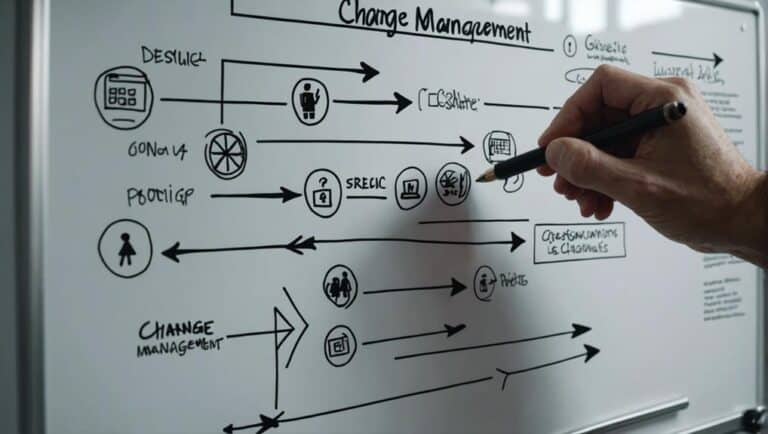As a leader navigating change within your organization, you may find yourself at a crossroads, wondering how to effectively steer your team through transitions. Understanding the nuances of change management best practices is a crucial step in ensuring not just survival, but thriving amidst change.
By exploring the intricacies of fostering a people-centric approach, leveraging proven models, and activating strong leadership, you hold the keys to unlocking the potential for successful change implementation. But what about the often overlooked aspect of addressing resistance?
Stay tuned to discover how mastering this facet can be a game-changer in your change management journey.
Key Takeaways
- Prioritize a people-centric approach to drive successful change.
- Utilize proven change management models for structured guidance.
- Empower through transparent communication to foster trust and alignment.
- Activate strong leadership to effectively address resistance and drive change.
Importance of People-Centric Approach
In change management, emphasizing a people-centric approach is essential for driving successful initiatives through understanding, belief, and engagement. Engaging employees is at the core of this approach, as they're key players in the success of organizational change efforts.
Effective communication strategies are vital in ensuring that employees feel informed, supported, and motivated throughout the change process. As a leader, it's crucial to involve the leadership team in championing this people-centric approach to change. By prioritizing clear communication, offering support, and providing opportunities for employee involvement, the leadership team can pave the way for successful change efforts.
Proactively addressing resistance and fostering belief and mobilization among employees are integral parts of driving and sustaining momentum during change. Therefore, adopting a people-centric approach not only enhances the chances of successful organizational change but also cultivates a culture of openness, trust, and collaboration within the workplace.
Utilizing Change Management Models
To effectively implement change management strategies, it is crucial to utilize established models that provide structured guidance and actionable steps for successful organizational transformation. By incorporating change management models such as Prosci's ADKAR and Lewin's model, you can bridge strategic planning with practical execution, enhancing your change management strategy. These models emphasize the significance of communication and engagement throughout the change process, ensuring successful outcomes and fostering belief in the transformation journey. Understanding and applying these proven models will also assist you in addressing resistance effectively, driving organizational transformation with precision. By leveraging these structured approaches, you can navigate complexities and lead your organization towards successful change initiatives.
| Change Management Models | Benefits |
|---|---|
| Prosci's ADKAR | Emphasizes individual change aspects and communication strategies |
| Lewin's Model | Facilitates strategic planning alignment with actionable steps |
Empowering Through Transparent Communication
Empower your organization by fostering a culture of transparent communication that builds trust and alignment during change initiatives. Transparent communication is pivotal in change management, as it cultivates trust through the provision of honest and clear information about the initiatives at hand. By being open and honest, you can enhance employee engagement and ensure that everyone is working towards the same objectives.
Additionally, transparent communication helps dispel rumors and misinformation that often lead to resistance and confusion within the organization.
To maintain transparency, it's crucial to provide regular updates and establish feedback channels that facilitate two-way dialogue. This approach not only ensures that information flows freely but also encourages employees to share their thoughts and concerns, further strengthening trust and alignment.
Clarity in communication regarding the reasons behind change is equally important, as it helps employees understand the purpose and necessity of the initiatives, fostering a sense of unity and common purpose. By prioritizing transparent communication, you can navigate change more effectively and lead your organization towards successful outcomes.
Activating Strong Leadership
Strong leadership plays a critical role in driving successful change initiatives, pivotal for overcoming challenges and inspiring organizational transformation. Effective change leaders must possess key attributes such as communication skills, engagement with stakeholders, resilience, adaptability, and alignment of goals to lead their teams through change effectively. Research indicates that 70% of change programs fail due to poor leadership, highlighting the significance of strong leadership in change management. By communicating a clear vision, engaging with stakeholders, and providing direction, leaders can increase employee engagement, commitment, and the overall success rates of change initiatives. Demonstrating resilience and strategic thinking enables leaders to navigate challenges confidently, inspiring trust among their teams. Additionally, aligning the organization towards a common goal fosters successful transformation. The table below summarizes the essential elements of activating strong leadership in change management:
| Leadership | Communication | Engagement | Resilience |
|---|---|---|---|
| Adaptability | Alignment |
Addressing Resistance Effectively
With effective leadership established, the focus now shifts to addressing resistance effectively during change initiatives. Resistance, manifested through inaction, decreased productivity, and rumors, can impede progress if left unaddressed. To combat this, establishing feedback loops and emphasizing clear communication channels are vital.
Identifying resistance early allows for timely interventions. Understanding that resistance may arise from fear, lack of information, or job security concerns is crucial in tailoring responses. Proactive measures such as involving employees in decision-making processes and providing support can help alleviate resistance.
By fostering a culture of open communication and transparency, leaders can create an environment where concerns are heard and addressed promptly. Engaging with resistant individuals to understand their perspectives and concerns demonstrates empathy and can aid in finding mutually beneficial solutions.
Addressing resistance effectively requires a strategic approach that values employee input and offers the necessary support to navigate the complexities of change.
Frequently Asked Questions
What Are the 5 C's of Change Management?
To excel in change management, remember the 5 C's: Communication fosters understanding, Collaboration drives success, Commitment fuels dedication, Consolidation brings cohesion, and Change Capability ensures adaptability. Embrace these principles for effective leadership in change initiatives.
What Is the Best Leadership Style for Change Management?
For effective change management, embrace transformational leadership. Inspire and empower employees through collaborative decision-making, fostering engagement, and effective communication. Prioritize adaptability and team empowerment to navigate change successfully.
What Are the 3 C's of Change Leadership?
Leading change requires mastering the 3 C's: Clear communication, Collaborative efforts, and Commendable commitment. By embracing these principles, you can effectively build trust, engage employees, align stakeholders, and manage resistance, fostering successful outcomes.
What Are the Five 5 Change Management Strategies?
To manage change effectively, utilize communication techniques, engage employees, address resistance, gain stakeholder buy-in, implement training programs, and adhere to project timelines. These strategies are crucial for successful change implementation within organizations.
Conclusion
In conclusion, embracing a people-centric approach, utilizing proven change management models, empowering through transparent communication, activating strong leadership, and addressing resistance effectively are essential for successful change initiatives.
Remember, leading change is like navigating a ship through stormy seas – with the right strategies and leadership, you can steer your team towards success and ensure smooth sailing towards organizational goals.
Keep your compass pointed towards effective change leadership to weather any storm.





